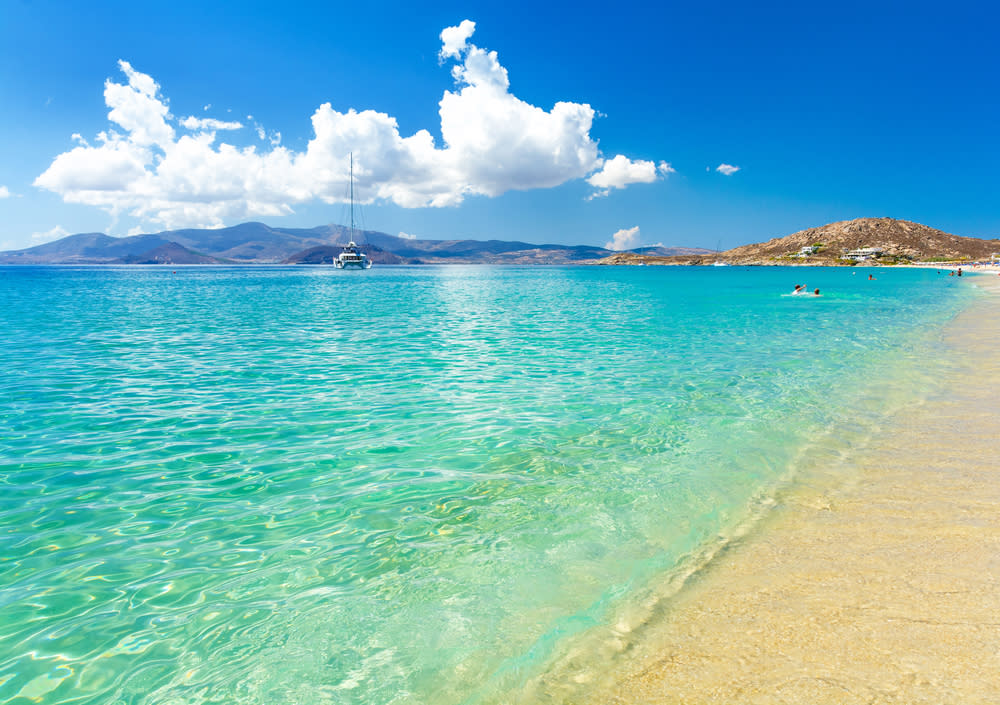More from Naxos
Main Menu
- 00:00
- 06:00
- 12:00
- 18:00
- 23:00
Naxos : Next 24-Hour Weather
Today - 18th April 2025
Sunrise 06:40
Sunset 19:56
Tomorrow - 19th April 2025
Sunrise 06:40
Sunset 19:56
Holiday Weather Now
Sorted by popularity:
Updated at 18:00 GMT
-
Temp feels like18°C65°F
-
Length of day13h 16m
-
Pressure29" (1012 hpa)
-
Visibility10 km (6miles)
-
Wind speed16 km/h
Sunrise 06:40
Sunset 19:56
-
Temp feels like:
18ºC (65 ºF)
-
Length of day:
13h 16m
-
Pressure:
29" (1012 hpa)
-
Visibility:
6 miles (10 km)
-
Wind speed:
16 km/h
Naxos, or Naxos Town, also commonly known as Hora, is the capital city of the Greek island of Naxos. It is located on the western side of Naxos Island, which is an island of the Cyclades island group located in the Aegean Sea.
<?xml:namespace prefix = o ns = "urn:schemas-microsoft-com:office:office" />
Naxos experiences a Mediterranean climate with a long, hot and dry summer and mild winters. Although summers are hot and sunny, the weather on Naxos is often slightly cooler than nearby resorts on mainland Greece and Turkey thanks to cooling Aegean breezes.
Summer lasts from May to September and is hot, sunny and very dry. May sees the start of the very dry period of summer weather as precipitation drops to just 17mm. This is accompanied by temperatures reaching an average of 22°C and hours of sunshine reaching ten hours per day. As such, May weather is extremely pleasant and ideal for those who want plenty of sunshine but wish to miss the hottest part of the year and the peak tourist season.
June is the start of the hottest summer weather, as average temperatures reach 25°C. Temperatures are likely to push towards 30°C on most days, and visitors can expect a whopping 13 hours of sunshine per day. Sunblock is essential and sunseekers should be wary of spending too long in the relentless sunshine. July is even hotter, with average temperatures of 27°C and peak daytime temperatures regularly making it past 30°C. August sees similar conditions.
The weather in June, July and August is classic Mediterranean-style beach weather. The days are long and the sunshine is virtually uninterrupted throughout the summer months. Visitors can expect the sunshine to last well into the evening, and evening conditions are ideal for relaxing in the warm night weather which never falls below about 20°C.
With all the heat and sunshine, the Aegean waters are a tempting haven, and sea temperatures are ideal for bathing. By June the water temperature reaches 21°C, and this rises throughout the summer, peaking at 23°C in August.
September is slightly cooler â" temperatures average 24°C â" but the dry weather persists, with just 12mm of rainfall expected.
The brief autumn (October and November) is characterised by milder temperatures but considerably higher rainfall. Rainfall shoots up to 51mm in October and rises again to 66mm in November, and although this is still fairly low (comparable to London at the same time of year), visitors should be prepared for the odd shower. Temperatures are relatively warm, averaging 21°C in October and 18°C in November, but there is a clear decrease in the amount of sunshine.
Winter (December to February) is mild but wet. January and February take joint honours as the coolest months, both averaging 13°C during the day. December and January both see high rainfall, with 102mm and 105mm respectively. Night-time temperatures can be quite chilly at times, especially if there is a sea wind blowing.
Spring (March and April) is progressively drier than winter. March sees rainfall drop to 63mm while April sees a modest 28mm. The weather can be very pleasant, despite the odd shower, and April can be quite warm, averaging a respectable 18°C.

















